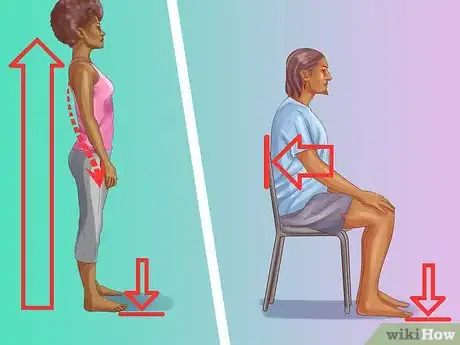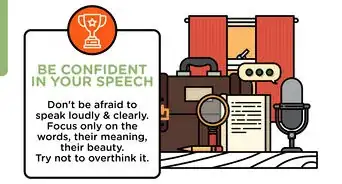This article was co-authored by Amy Chapman, MA. Amy Chapman MA, CCC-SLP is a vocal therapist and singing voice specialist. Amy is a licensed and board certified speech & language pathologist who has dedicated her career to helping professionals improve and optimize their voice. Amy has lectured on voice optimization, speech, vocal health, and voice rehabilitation at universities across California, including UCLA, USC, Chapman University, Cal Poly Pomona, CSUF, CSULA. Amy is trained in Lee Silverman Voice Therapy, Estill, LMRVT, and is a part of the American Speech and Hearing Association.
There are 8 references cited in this article, which can be found at the bottom of the page.
This article has been viewed 22,115 times.
Some people have naturally softer or quieter voices, while others are able to speak loudly with ease. When you want to be heard in a noisy environment, the most effective way to control the volume of your voice is to learn how to project your voice. Projection and proper breathing will protect your voice from unnecessary strain and allow you to be heard even in crowded areas.
Steps
Strengthening Your Voice
-
1Practice breath exercises. It may sound silly, but you should practice breathing. This will help you to become more conscious of the way that you are breathing and to deepen your breaths.
- Deep breathing is important to project your voice. In order to speak loudly, you need to use more air than you do when you speak quietly. Deep breathing, as opposed to short and shallow breaths, ensures that you have enough air to project your voice.
- Always try to breathe through your nose. Breathing through your nose is your body’s natural way of filtering air into your lungs and is the most efficient way to breathe deeply.
-
2Breathe from your diaphragm. The diaphragm is a dome shaped muscle at the bottom of your ribcage and is the main muscle used in respiration. Breathing with your diaphragm helps to open your lungs so you can take in the most air possible.
- To find your diaphragm, sit comfortably or lie down. Placing your left hand on your upper chest, place your right hand on your abdomen just below where your rib cage ends. Breathe deeply in and out through your nose. Your left hand should remain still on your chest while your right hand moves up and down. If your left hand moves while you breathe, you are breathing too shallowly and aren’t utilizing your diaphragm. [1]
Advertisement -
3Practice breathing with your diaphragm. When you practice specific breathing techniques that use your diaphragm, you strengthen these muscles and become more aware of how deeply you are breathing.
- To practice breathing using your diaphragm, maintain the same comfortable position with your left and right hand placed on your chest and abdomen respectively. Practice taking deep breaths through your nose, tightening your stomach muscles and breathing out through pursed lips. This will help to strengthen your diaphragm muscles and instill good breathing patterns. You can practice diaphragm breathing for as long as you feel comfortable, but try to take at least 15 deep breaths.[2]
- Try different breathing exercises that focus on taking deep breaths. One popular exercise is called 4-7-8 breathing. Here, you inhale deeply through your nose for four seconds. Then, hold the air in your lungs for seven seconds before taking eight seconds to exhale slowly. This breathing technique strengthens your muscle control and many people find it to be very calming.
-
4Strengthen your core muscles. We breathe using our core muscles and our diaphragm, so keeping these muscles strong through regular exercise is a great way to strengthen your breathing.
- Abdominal exercises like planks, crunches, planks, and side planks are all great ways to target your abdominal muscles.[3]
- Regular cardiovascular exercise, like running or cycling, will also strengthen your core muscles and improve your cardio-respiratory function. A healthy cardio-respiratory function means that your body is able to efficiently transport oxygen throughout your body.[4]
-
5Maintain good posture. Good posture allows your muscles and lungs to fully expand so you can take in the most air possible. Poor posture compresses your respiratory system and distorts your breathing.[5]
- When standing, you should stand tall by straightening your back and drawing your shoulder blades together. Your arms and hands should hang comfortably at your sides, and your weight should be balanced primarily on the balls of your feet.[6]
- When sitting, keep your feet on the ground and avoid crossing your legs. Use the back of the seat to support your lower and middle back while you keep your shoulders parallel above your hips.
Projecting Your Voice
-
1Use your breath to project your voice. Voice projection allows you to control the volume of your voice. Some people are naturally louder than others, but learning how to correctly project your voice will ensure that you can be heard over a crowd.[7]
- Breathe deeply using your diaphragm to draw enough air into your lungs. Breath is what powers our voices; when we breathe shallowly we do not have enough air to project our voices without straining our vocal cords.
- Imagine filling your lungs from top to bottom. As you breathe, imagine that you are completely filling up your lungs with air and breathe until you feel as though you’ve reached your lung's capacity.
-
2Force air out when you speak. As you speak, push the air from your deep breaths out. Notice that when you push the air out, your diaphragm and abdominal muscles contract but that you don’t feel a strain on your vocal cords.
- Continue to speak loudly and with authority so that your voice will carry across the room.
-
3Articulate your words. Articulation refers to the careful pronunciation of each sound in a word. When we speak articulately, it is easier for others to understand the words that we are saying.
- In a noisy room, there are background noises that might interfere with your audience's ability to understand what you are saying. Speaking articulately and deliberately will help your audience hear and understand what you are saying.
-
4Avoid straining your vocal cords. If you begin to feel your throat tightening up while you are projecting, stop speaking as soon as you are able to.
- When you strain your voice you are putting stress on the muscles and ligaments of your vocal cords and throat. Over time, stress can irreversibly damage your vocal cords.
- If you feel yourself straining, you should return to your attention to your breaths. If you are breathing deeply enough, you should not need to strain your voice to be heard. You may need to drink water to help lubricate your throat to make speaking more comfortable after straining.
Protecting Your Voice
-
1Hydrate. Drinking lots of water will help to lubricate your throat, prevent your voice cords from drying out, and making your voice sound hoarse.[8]
- Alcohol, smoking, and caffeine are all drying or constricting to your vocal cords. It is best to avoid these substances before situations where you need to project your voice.
- Some medications, like antihistamines, are also drying to your vocal cords. Plan to drink more water if you are taking these medications in order to protect your voice.
-
2Rest your voice. Your vocal cords are fragile and can become easily overworked. If you find yourself straining while you are projecting your voice, it is best to take a break and rest your vocal cords before attempting to project again.
- If you are sick, especially with a respiratory condition, you should also rest your voice since illnesses put extra stress on your respiratory system.
-
3Continue to practice breathing exercises. Even though you have used breathing exercises to learn how to project your voice, you should continue to exercise your diaphragm and respiratory muscles to keep them strong.
- Yoga or other meditative activities that focus on deep and thoughtful breathing are great ways to incorporate breathing exercises into your lifestyle.
Expert Q&A
Did you know you can get expert answers for this article?
Unlock expert answers by supporting wikiHow
-
QuestionWhy can't I speak louder sometimes?
 Amy Chapman, MAAmy Chapman MA, CCC-SLP is a vocal therapist and singing voice specialist. Amy is a licensed and board certified speech & language pathologist who has dedicated her career to helping professionals improve and optimize their voice. Amy has lectured on voice optimization, speech, vocal health, and voice rehabilitation at universities across California, including UCLA, USC, Chapman University, Cal Poly Pomona, CSUF, CSULA. Amy is trained in Lee Silverman Voice Therapy, Estill, LMRVT, and is a part of the American Speech and Hearing Association.
Amy Chapman, MAAmy Chapman MA, CCC-SLP is a vocal therapist and singing voice specialist. Amy is a licensed and board certified speech & language pathologist who has dedicated her career to helping professionals improve and optimize their voice. Amy has lectured on voice optimization, speech, vocal health, and voice rehabilitation at universities across California, including UCLA, USC, Chapman University, Cal Poly Pomona, CSUF, CSULA. Amy is trained in Lee Silverman Voice Therapy, Estill, LMRVT, and is a part of the American Speech and Hearing Association.
Voice & Speech Coach So, to project your voice or speak louder, a few things have to be in place. Your vocal cords have to be healthy first of all. You can't push your voice out if your vocal cords are inflamed or you have any laryngitis. Second, you can't be sick. If you're feeling ill, you're not going to be able to speak out.
So, to project your voice or speak louder, a few things have to be in place. Your vocal cords have to be healthy first of all. You can't push your voice out if your vocal cords are inflamed or you have any laryngitis. Second, you can't be sick. If you're feeling ill, you're not going to be able to speak out.
Warnings
- If you experience any pain when talking or breathing, you should contact your physician. They may refer you to an otolaryngologist, who is a specialist that treats ear, nose, and throat conditions.⧼thumbs_response⧽
- Avoid chewing gum, as it will make it much harder for you to articulate and project your words.⧼thumbs_response⧽
References
- ↑ http://www.dailymail.co.uk/health/article-140722/How-breathe-way-good-health.html
- ↑ http://my.clevelandclinic.org/health/diseases_conditions/hic_Understanding_COPD/hic_Pulmonary_Rehabilitation_Is_it_for_You/hic_Diaphragmatic_Breathing
- ↑ http://www.mayoclinic.org/healthy-lifestyle/fitness/multimedia/core-strength/sls-20076575
- ↑ https://www.scientificamerican.com/article/if-a-persons-lung-size-ca/
- ↑ Amy Chapman, MA. Voice & Speech Coach. Expert Interview. 18 October 2019.
- ↑ http://my.clevelandclinic.org/health/diseases_conditions/hic_Posture_for_a_Healthy_Back
- ↑ http://www.lisabmarshall.com/2015/07/23/how-to-project-your-voice/
- ↑ https://www.nidcd.nih.gov/health/taking-care-your-voice








































































Medical Disclaimer
The content of this article is not intended to be a substitute for professional medical advice, examination, diagnosis, or treatment. You should always contact your doctor or other qualified healthcare professional before starting, changing, or stopping any kind of health treatment.
Read More...